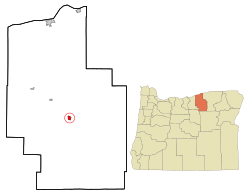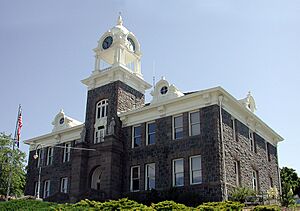Heppner, Oregon facts for kids
Quick facts for kids
Heppner, Oregon
|
||
|---|---|---|

The Agricultural Collection Building of the Morrow County Museum in Heppner
|
||
|
||
| Nickname(s):
Gateway to the Blues
|
||

Location in Oregon
|
||
| Country | United States | |
| State | Oregon | |
| County | Morrow | |
| Incorporated | 1887 | |
| Area | ||
| • Total | 1.24 sq mi (3.20 km2) | |
| • Land | 1.23 sq mi (3.19 km2) | |
| • Water | 0.01 sq mi (0.02 km2) | |
| Elevation | 2,011 ft (613 m) | |
| Population
(2020)
|
||
| • Total | 1,187 | |
| • Density | 965.04/sq mi (372.65/km2) | |
| Time zone | UTC−8 (Pacific) | |
| • Summer (DST) | UTC−7 (Pacific) | |
| ZIP code |
97836
|
|
| Area code(s) | 458 and 541 | |
| FIPS code | 41-33550 | |
| GNIS feature ID | 2410745 | |
| Website | www.cityofheppner.com | |
Heppner is a city in Morrow County, Oregon, United States. It is also the county seat, which means it's where the county government is located. In 2020, about 1,187 people lived there.
Heppner is part of the larger Pendleton-Hermiston Micropolitan Area. The city got its name from Henry Heppner, a well-known businessman.
Contents
History of Heppner
Early Native American Life
For over 10,000 years, Native Americans lived and traveled through the land around Heppner. This area is between the Columbia Gorge and the Blue Mountains. Ancient rock carvings, called petroglyphs, have been found nearby.
In 1855, the U.S. Government made a treaty with the main tribes of the area. These tribes were the Cayuse, Umatilla, and Walla Walla. They agreed to give up over 6.4 million acres of land to the United States. This land is now in northeastern Oregon and southeastern Washington.
European-American Settlement
Before Heppner was officially founded in 1872, ranchers used the area. They brought sheep and cattle here as early as 1858. These early ranchers found lots of rye grass along the creeks.
Heppner was first called Standsbury Flats. This name came from George W. Standsbury, one of the first European-American settlers. In 1872, a merchant named Colonel (Col.) Jackson L. Morrow teamed up with Henry Heppner. They built a store where May and Main streets are today. Soon after, a mail and stagecoach service started. It ran between Pendleton and The Dalles, passing through Heppner.
Col. Jackson L. Morrow later became part of the Oregon Legislative Assembly. He helped create a new county for Heppner. This new county was made from parts of Umatilla County and Wasco County. The assembly named the new county "Morrow" in his honor.
Heppner was chosen as the temporary county seat when Morrow County was formed. In 1886, Heppner won an election against nearby Lexington to become the permanent county seat. The city was officially made a city on February 9, 1887.
In 1888, the Oregon Railroad and Navigation Company built a railroad line to Heppner. This line connected the city to the Columbia River.
The historic Morrow County Courthouse was built in 1902-03. It is one of Oregon's oldest courthouses that is still used today. In 1985, it was added to the National Register of Historic Places.
The Great Flood of 1903
Heppner faced a terrible flash flood on June 14, 1903. A sudden, heavy rainstorm with hail caused a natural dam to break. This sent a huge wall of water and debris rushing down Willow Creek and through the city.
It is believed that 238 people drowned, which was about a quarter of the city's population. This makes it the deadliest natural disaster in Oregon's history. The flood also caused almost $1 million in property damage. Nearby towns like Ione and Lexington were also badly hit. In 1983, the Willow Creek Dam was finished just outside the city. This dam helps prevent future floods.
Rebuilding After the Flood
By the early 1900s, the railroad and new roads made Heppner a busy trade center. It was a place where farm products like wheat, sheep, and cattle were bought and sold. Even after the flood and two fires in 1918, the community rebuilt. These fires destroyed City Hall, the Palace Hotel, the library, many businesses, and over 30 homes.
One new building was the Heppner Hotel, which opened in 1920. It was a community meeting place and housed different businesses until 1972.
Later History
In 1940, a large sawmill was built by the Heppner Lumber Company. This mill helped the local economy a lot. It was destroyed by fire in 1949 but was rebuilt. The Kinzua Lumber Company later bought it and moved its main office to Heppner. In 1999, the mill closed, which was a big loss for Heppner. Nearly 200 jobs were lost.
Population Information
| Historical population | |||
|---|---|---|---|
| Census | Pop. | %± | |
| 1880 | 318 | — | |
| 1890 | 675 | 112.3% | |
| 1900 | 1,146 | 69.8% | |
| 1910 | 880 | −23.2% | |
| 1920 | 1,324 | 50.5% | |
| 1930 | 1,190 | −10.1% | |
| 1940 | 1,140 | −4.2% | |
| 1950 | 1,648 | 44.6% | |
| 1960 | 1,661 | 0.8% | |
| 1970 | 1,429 | −14.0% | |
| 1980 | 1,498 | 4.8% | |
| 1990 | 1,412 | −5.7% | |
| 2000 | 1,395 | −1.2% | |
| 2010 | 1,291 | −7.5% | |
| 2020 | 1,187 | −8.1% | |
| source: | |||
Recent Population Numbers
As of July 1, 2016, the estimated population of Heppner was 1,297 people.
2010 Census Details
In 2010, there were 1,291 people living in Heppner. There were 559 households, with 370 of them being families. The city had about 1,050 people per square mile.
About 26% of households had children under 18 living with them. Most households (53.3%) were married couples. The average age in the city was 45.9 years old.
Geography and Location
Heppner is located between the Columbia River to the north and the Blue Mountains to the southeast. The city is on Oregon Route 74. It is about 60 miles (97 km) southwest of Pendleton. It is also about 185 miles (298 km) east of Portland.
Route 74 is part of the Blue Mountain Scenic Byway. This byway is about 130 miles (209 km) long. It connects Interstate 84 along the Columbia River to the North Fork John Day River. Part of this scenic route follows the Willow Creek area through Heppner.
Heppner is upstream from other towns like Lexington, Ione, and Arlington. The city covers about 1.24 square miles (3.20 km2) in total. Most of this area is land, with a small amount of water.
Climate
Heppner has a warm-summer Mediterranean climate. This means it has warm, dry summers and mild, wet winters. The hottest temperature ever recorded in Heppner was 110 °F (43 °C) on August 10, 1898. The coldest temperature was -19 °F (-28 °C) on January 10 and 12, 1909.
| Climate data for Heppner, Oregon, 1991–2020 normals, extremes 1893–present | |||||||||||||
|---|---|---|---|---|---|---|---|---|---|---|---|---|---|
| Month | Jan | Feb | Mar | Apr | May | Jun | Jul | Aug | Sep | Oct | Nov | Dec | Year |
| Record high °F (°C) | 70 (21) |
75 (24) |
80 (27) |
92 (33) |
100 (38) |
109 (43) |
108 (42) |
110 (43) |
99 (37) |
92 (33) |
80 (27) |
75 (24) |
110 (43) |
| Mean maximum °F (°C) | 61.9 (16.6) |
62.4 (16.9) |
68.8 (20.4) |
76.6 (24.8) |
87.1 (30.6) |
93.2 (34.0) |
99.1 (37.3) |
98.7 (37.1) |
90.9 (32.7) |
80.0 (26.7) |
68.2 (20.1) |
59.8 (15.4) |
100.8 (38.2) |
| Mean daily maximum °F (°C) | 43.6 (6.4) |
47.4 (8.6) |
54.7 (12.6) |
60.8 (16.0) |
69.4 (20.8) |
76.6 (24.8) |
86.8 (30.4) |
86.1 (30.1) |
77.3 (25.2) |
63.8 (17.7) |
51.0 (10.6) |
42.5 (5.8) |
63.3 (17.4) |
| Daily mean °F (°C) | 35.6 (2.0) |
38.3 (3.5) |
44.2 (6.8) |
49.3 (9.6) |
56.9 (13.8) |
63.1 (17.3) |
71.0 (21.7) |
70.4 (21.3) |
62.8 (17.1) |
51.7 (10.9) |
41.6 (5.3) |
34.9 (1.6) |
51.7 (10.9) |
| Mean daily minimum °F (°C) | 27.6 (−2.4) |
29.2 (−1.6) |
33.6 (0.9) |
37.8 (3.2) |
44.5 (6.9) |
49.5 (9.7) |
55.1 (12.8) |
54.7 (12.6) |
48.3 (9.1) |
39.5 (4.2) |
32.2 (0.1) |
27.2 (−2.7) |
39.9 (4.4) |
| Mean minimum °F (°C) | 11.9 (−11.2) |
14.2 (−9.9) |
22.9 (−5.1) |
27.4 (−2.6) |
33.0 (0.6) |
39.1 (3.9) |
44.5 (6.9) |
44.7 (7.1) |
37.1 (2.8) |
25.9 (−3.4) |
17.7 (−7.9) |
11.4 (−11.4) |
4.3 (−15.4) |
| Record low °F (°C) | −19 (−28) |
−18 (−28) |
3 (−16) |
15 (−9) |
25 (−4) |
31 (−1) |
32 (0) |
35 (2) |
19 (−7) |
10 (−12) |
−9 (−23) |
−18 (−28) |
−19 (−28) |
| Average precipitation inches (mm) | 1.32 (34) |
1.07 (27) |
1.36 (35) |
1.46 (37) |
1.71 (43) |
1.35 (34) |
0.31 (7.9) |
0.28 (7.1) |
0.43 (11) |
1.17 (30) |
1.37 (35) |
1.26 (32) |
13.09 (333) |
| Average snowfall inches (cm) | 3.0 (7.6) |
3.4 (8.6) |
0.9 (2.3) |
0.1 (0.25) |
0.0 (0.0) |
0.0 (0.0) |
0.0 (0.0) |
0.0 (0.0) |
0.0 (0.0) |
0.2 (0.51) |
0.9 (2.3) |
4.3 (11) |
12.8 (32.56) |
| Average precipitation days (≥ 0.01 in) | 11.0 | 10.1 | 11.8 | 11.0 | 10.2 | 7.2 | 2.7 | 2.3 | 3.7 | 8.6 | 11.7 | 12.1 | 102.4 |
| Average snowy days (≥ 0.1 in) | 2.5 | 2.0 | 0.6 | 0.1 | 0.0 | 0.0 | 0.0 | 0.0 | 0.0 | 0.1 | 0.7 | 2.4 | 8.4 |
| Source 1: NOAA | |||||||||||||
| Source 2: National Weather Service | |||||||||||||
Fun Events in Heppner
Heppner has a special "A Wee Bit O'Ireland" celebration around Saint Patrick's Day each year. The city also hosts the annual Blue Mountain Century Bikeway. This is a scenic bike ride loop of about 108 miles (174 km) that starts and ends in Heppner.
Economy and Education
In 2002, the biggest employers in Heppner included Morrow County and the Morrow County Health District. The Morrow County School District, the Heppner Ranger District, and the Bank of Eastern Oregon also provided many jobs.
Heppner is served by the Morrow School District. This district includes Heppner Junior/Senior High School and Heppner Elementary. The city also has the Heppner Branch of the Oregon Trail Library District. This library is part of Oregon's Sage Library System.
Famous People from Heppner
- John Kilkenny – A judge for the U.S. District Court and the U.S. Court of Appeals.
- Greg Smith – An Oregon State Representative for District 57.
See also
 In Spanish: Heppner (Oregón) para niños
In Spanish: Heppner (Oregón) para niños





